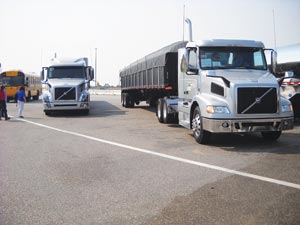Volvo Shows Adaptive Loading System; Fleets Cite Safety, Fuel Benefits in Tests

HEYBURN, Idaho — Volvo Trucks rolled out a drivetrain system that management hopes will give the company a larger presence among liquid and bulk haulers, regional distribution carriers and trucking companies often dealing with loads that diminish over time or with empty backhauls.
The adaptive loading system, built around an electronically controlled suspension, switches automatically between 6x2 and 4x2 power configurations with the use of a forward tractor tandem axle that can be lifted off the ground.
Company managers said at a marketing event here Aug. 20 that when a trailer is mostly full, the lift axle places the wheels on the ground so they can bear weight and roll freely like trailer wheels. In contrast, when a trailer is mostly or completely empty and the tractor axle is not needed, up it goes and the 18-wheeler becomes a more efficient (albeit less commanding) 14-wheeler.
“Volvo has long been known as a highway tractor manufacturer in the longhaul segment,” said Wade Long, Volvo director of product marketing. “But this will help us on regional growth. It’s a second opportunity for growth.”
The lift axle is made by Link Manufacturing Ltd. of Sioux Center, Iowa, and the drive axle is from Meritor Inc.
Volvo announced the system at the Mid-America Trucking Show in March, having started limited production in 2014. Full production will start in January.
During briefings here and in Salt Lake City, and ride-and-drive demonstrations on the highways in between, Volvo managers said the new system is not the same as a traditional 6x2 configuration, where both axles always are on the ground — a drive axle and a tag axle.
(In the more common 6x4 configuration, both tractor tandem axles receive power from the engine.)
Traditional 6x2s often have been criticized for their lack of traction, but Volvo has addressed the problem with “dynamic weight transfer,” said Chris Stadler, product marketing manager for regional haul.
Beyond just axle up or down, Stadler said, Volvo software takes input from sensors and balances weight on the tandem tractor axles as needed. For a fully loaded trailer, the weight is balanced evenly between the two.
For a lighter load, the drive axle takes most but not all of the weight. Eventually, when the load is light enough, the axle lifts. Extra weight also can be shifted to the drive axle when there is a need for more traction.
The company’s customers, fleet executives, at the event said the axle-up configuration improves safety —the tractor’s wheelbase becomes longer and weight is split between the drive and steer axles, leading to better steering and handling.
“Everything has been positive with this,” said Joel Morrow, vice president and part-owner of his family’s Ploger Transportation, a small truckload carrier in Bellevue, Ohio.
“We’ve improved fuel efficiency, and they have better handling. The trucks have helped with our driver recruitment and retention. We have drivers asking to get into trucks with lift axles,” Morrow said.
Clay Handy, president of Handy Truck Line in Paul, Idaho, said he already had been thinking about converting to regular 6x2 tractors, so when Volvo contacted him about participating in a prototype test, “We jumped on it immediately.”
Handy said he might switch all of his 120 trucks to adaptive loading.
J.W. Ray said he enjoys driving an adaptive loading truck for Idaho Milk Transport of Burley, Idaho. September marks his 40th anniversary as a driver, and during that time he has racked up 6 million miles.
“This is the most expensive toy I’ve ever gotten to play with,” a smiling Ray said.
As to how the benefits are generated, the Volvo and fleet executives said that when the tractor — either a VNL or a VNM with an 11- or 13-liter Volvo engine — is operating as a 4x2, there is less rolling resistance with 14 wheels rather than 18.
Not as many tires are scrubbing through turns, and there is no slippage, as with a 6x4 configuration when wheels are not working in unison.
As for safety, the lifted forward axle makes for a longer wheelbase and more weight placed on the drive and steer axles. The fleet executives said their drivers mentioned more precise steering and better traction and handling, especially in bad weather.
Volvo’s Long and Stadler also said adaptive loading works well with the company’s adaptive-gearing transmission.
For a full load, the automated manual transmission works as an 11-speed, direct-drive model. For lighter loads, the AMT adds a 12th overdrive gear.

